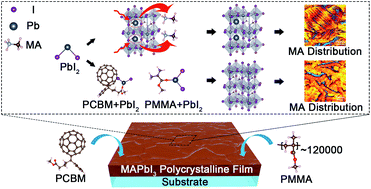CH3NH3+ and Pb immobilization through PbI2 binding by organic molecule doping for homogeneous organometal halide perovskite films†
Abstract
Organic molecule doping is one of the main strategies to enhance the performance and sustainability of organometal halide perovskite polycrystalline films. However, the mechanisms for interpreting organic molecule doping are poorly understood, limiting the development of perovskite solar cells (PSCs). Herein, we revisit regular perovskite films and study the doping effects of two typical organic molecules. With PCBM and PMMA doping, the CH3NH3PbI3 films showed higher homogeneity in their crystalline structure, chemical composition, surface topography and potential. The binding of organic molecules to PbI2 inhibited the migration of Pb and the aggregation of CH3NH3+ vacancies. PMMA induced the formation of CH3NH3PbI3 nanofibers, which bridged the grains and increased the intergrain connectivity. The CH3NH3PbI3 films doped with organic molecules showed a five-fold increase in photoexcited carrier lifetime (>1 μs) with an enhanced photoelectric conversion efficiency and stability. Our work offers insight into the doping of organic molecules in perovskite films and paves the way for the further optimization of PSCs.



 Please wait while we load your content...
Please wait while we load your content...